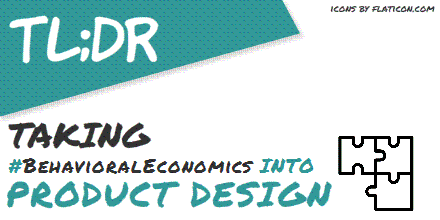If you are reading this chances are you are aware of the revolution that has been taking place in the economics called Behavioral Economics. For those of you that haven’t been hit by this game-changing idea, I’ll try to condense it for you.

“Behavioral Economics” its economics where the individuals don’t always behave as rational, cold hearted subjects that make decisions based on what’s more economic beneficial for them. Instead of the classical approach, this new insight into economics recognizes that psychology plays an important part in the decision process. This new field has proved that individuals don’t usually consider every aspect of a problem but use heuristics- rules of thumb- when confronted with any decision. Heuristics are fast, simple “rules of decision” but can be wrong. Therefore individuals will make predictable mistakes when facing challenges that are not as intuitive as they look like.
When designing a product, designers often commit the same sin classical economist do, assume that the user will look at their design and rationally decide what to do with it. This is the reason why we see products that are carefully designed and yet, no user can get their hands on them without taking a look at the manual.
Recognizing that the user will not pay all the attention to your product, testing the interactions and refine the whole experience may seem like a solution for this situation. This is UX (User experience design) and is the approach most companies are using now to improve their products.
This seems like a reasonable approach, yet we are missing the real power of this concept. Heuristics can be used to predict behavioral outcomes, Why not harnessing the power of that knowledge to the design itself?. Learn from user psychology, the shortcuts the user will unconsciously use when interacting with your product and use them to guide them to their goals. Use strategies that help the users to take advantage of their hardwired way of thinking. This is Behavioral Design.

Designs that use this approach from the moment of their conception can face new challenges, thus having more chances of success. Since its design is not a shoot in the dark. Those products are affecting behavior by learning how we make the decisions that lead us to take a particular action to prevent or benefit from natural biases.
Bearing in consideration the behavioral aspect while designing a product will not only increase adoption and retention but will help considerably reduce the effort in polishing the product. It will foresee challenges that traditional design would never stop to think.
Recap

Originally published at behaviourbydesign.com on May 16, 2016.
Are you looking for a passionate team that can help you envision, design, and build amazing products? Use the link 👇 to schedule a call.

